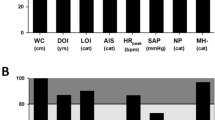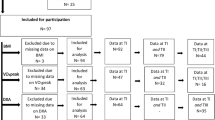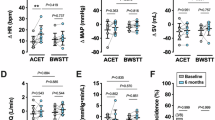Abstract
Study design
Multicentre, cross-sectional study.
Objectives
To identify which markers of obesity, injury characteristics and autonomic function variables are related to cardiovascular disease (CVD) risk after spinal cord injury (SCI), and establish cut-points for detection and risk management.
Setting
Eight SCI rehabilitation centres in the Netherlands.
Methods
Individuals (n = 257) with a traumatic, chronic (≥10 years) SCI, with age at injury between 18 and 35 years, completed a self-report questionnaire and a one-day visit to a rehabilitation centre for testing. Three anthropometric measures were tested: body mass index (BMI); waist circumference (WC); and waist-to-height ratio (WHtR). Injury characteristics included: American Spinal Injury Association impairment scale (AIS); duration of injury (DOI); and neurological level of injury (LOI). Cardiovascular autonomic function was assessed from peak heart rate during maximal exercise (HRpeak). Systolic arterial pressure (SAP) and aerobic capacity (VO2peak) were also determined. CVD risk was calculated using the Framingham risk score (FRS).
Results
All anthropometric variables were associated with FRS, with WC showing the strongest correlation (r = 0.41, p < 0.001) and greatest area under the curve (0.73) for 10-year CVD risk (%). WC, DOI, SAP, HRpeak, LOI, and VO2peak (variable importance: 0.81, 1.0, 0.98, 0.98, 0.66, 0.68, respectively) were important predictive variables for 10-year CVD risk in individuals with SCI.
Conclusions
We confirm that WC is a simple, practical measure of CVD risk, and along with DOI and markers of cardiovascular autonomic function, plays a role in the increased CVD risk following SCI.
Similar content being viewed by others
Log in or create a free account to read this content
Gain free access to this article, as well as selected content from this journal and more on nature.com
or
Data availability
The datasets generated and/or analysed during the current study are available from the corresponding author on reasonable request.
References
Kumar R, Lim J, Mekary RA, Rattani A, Dewan MC, Sharif SY, et al. Traumatic spinal injury: global epidemiology and worldwide volume. World Neurosurg. 2018;113:345–63.
Rick Hansen Institute. Rick Hansen Spinal Cord Injury Registry A look at traumatic spinal cord injury in Canada in 2017 [Internet]. 2017 [cited 2019 May 9]. https://rickhanseninstitute.org/images/stories/Article_PDFs/SCI_Report_dec9_web1.pdf.
Garshick E, Kelley A, Cohen SA, Garrison A, Tun CG, Gagnon D, et al. A prospective assessment of mortality in chronic spinal cord injury. Spinal Cord. 2005;43:408–16.
Buring JE, Hennekens CH. Prevention of cardiovascular disease. J Gen Intern Med. 2007;5:S54–7.
Cragg JJ, Noonan VK, Krassioukov A, Borisoff J. Cardiovascular disease and spinal cord injury: results from a national population health survey. Neurology. 2013;81:723–8.
Burns S, Biering-Sørensen F, Donovan W, Graves D, Jha A, Johansen M, et al. International Standards for Neurological Classification of Spinal Cord Injury, Revised 2011. Top Spinal Cord Inj Rehabil. 2012;18:85–99.
Krassioukov A. Autonomic function following cervical spinal cord injury. Respir Physiol Neurobiol. 2009;169:157–64.
Claydon V, Krassioukov AV. Orthostatic Hypotension and Autonomic Pathways after Spinal Cord Injury. J Neurotrauma. 2006;23:1713–25.
Ravensbergen HJC(Rianne), Post MWM, Slootman HJ, Claydon VE, van der Woude LHV, de Groot S. Cardiovascular function after spinal cord injury: prevalence and progression of dysfunction during inpatient rehabilitation and 5 years following discharge. Neurorehabil Neural Repair. 2013;28:219–29.
Phillips AA, Krassioukov AV. Contemporary cardiovascular concerns after spinal cord injury: mechanisms, maladaptations, and management. J Neurotrauma. 2015;32:1927–42.
Collins HL, Rodenbaugh DM, DiCarlo SE. Spinal cord injury alters cardiac electrophysiology and increases the susceptibility to ventricular arrhythmias. Prog Brain Res. 2006;152:275–88.
Van Loan MD, McCluer S, Mark Loftin J, Boileau RA. Comparison of physiological responses to maximal arm exercise among able-bodied, paraplegics and quadriplegics. Paraplegia. 1987;25:397–405.
Ravensbergen HJ (Rianne), de Groot S, Post MW, Bongers-Janssen HM, van der Woude LH, Claydon VE. Is there an association between markers of cardiovascular autonomic dysfunction at discharge from rehabilitation and participation 1 and 5 years later in individuals with spinal cord injury?. Arch Phys Med Rehabil. 2016;97:1431–9.
Anderson KD. Targeting recovery: priorities of the spinal cord-injured population. J Neurotrauma. 2004;21:1371–83.
Myers J, Lee M, Kiratli J. Cardiovascular disease in spinal cord injury. Am J Phys Med Rehabil. 2007;86:142–52.
Bauman WA, Kahn NN, Grimm DR, Spungen AM. Risk factors for atherogenesis and cardiovascular autonomic function in persons with spinal cord injury. Spinal Cord. 1999;37:601–16.
Gorgey AS, Dolbow DR, Dolbow JD, Khalil RK, Castillo C, Gater DR. Effects of spinal cord injury on body composition and metabolic profile – Part I. J Spinal Cord Med. 2014;0:1–10.
Buchholz AC, McGillivray CF, Pencharz PB. Physical activity levels are low in free-living adults with chronic paraplegia. Obes Res [Internet]. 2003;11:563–70. http://www.embase.com/search/results?subaction=viewrecord&from=export&id=L37313017%5Cnhttp://sfx.library.uu.nl/utrecht?sid=EMBASE&issn=10717323&id=doi:&atitle=Physical+activity+levels+are+low+in+free-living+adults+with+chronic+paraplegia.&stitle=Obes.+Res.
Spungen AM, Adkins RH, Stewart CA, Wang J, Pierson RNJ, Waters RL, et al. Factors influencing body composition in persons with spinal cord injury: a cross-sectional study. J Appl Physiol [Internet]. 2003;95:2398–407. http://ovidsp.ovid.com/ovidweb.cgi?T=JS&PAGE=reference&D=med4&NEWS=N&AN=12909613%5Cnhttp://ovidsp.ovid.com/ovidweb.cgi?T=JS&PAGE=reference&D=emed9&NEWS=N&AN=37444985.
Monroe MB, Tataranni PA, Pratley R, Manore MM, Skinner JS, Ravussin E. Lower daily energy expenditure as measured by a respiratory chamber in subjects with spinal cord injury compared with control subjects. Am J Clin Nutr [Internet]. 1998;68:1223–7. http://ovidsp.ovid.com/ovidweb.cgi?T=JS&PAGE=reference&D=emed4&NEWS=N&AN=1998411080%5Cnhttp://search.ebscohost.com/login.aspx?direct=true&db=cin20&AN=107179509&site=ehost-live.
Maruyama Y, Mizuguchi M, Yaginuma T, Kusaka M, Yoshida H, Yokoyama K, et al. Serum leptin, abdominal obesity and the metabolic syndrome in individuals with chronic spinal cord injury. Spinal Cord. 2008;46:494–9.
Edwards LA, Bugaresti JM, Buchholz AC. Visceral adipose tissue and the ratio of visceral to subcutaneous adipose tissue are greater in adults with than in those without spinal cord injury, despite matching waist circumferences. Am J Clin Nutr. 2008;87:600–7.
Mahabadi AA, Massaro JM, Rosito GA, Levy D, Murabito JM, Wolf PA, et al. Association of pericardial fat, intrathoracic fat, and visceral abdominal fat with cardiovascular disease burden: the Framingham Heart Study. Eur Heart J. 2009;30:850–6.
Laughton G, Buchholz A, Martin Ginis K, Goy R. Lowering body mass index cutoffs better identifies obese persons with spinal cord injury. Spinal Cord [Internet]. 2009;47:757–62. www.nature.com/sc [cited 2019 May 9].
Ravensbergen HJC(Rianne), Lear SA, Claydon VE. Waist Circumference Is the Best Index for Obesity-Related Cardiovascular Disease Risk in Individuals with Spinal Cord Injury. J Neurotrauma. 2013;31:292–300.
Adriaansen JJE, Van Asbeck FWA, Lindeman E, Van Der Woude LHV, De Groot S, Post MWM. Secondary health conditions in persons with a spinal cord injury for at least 10 years: design of a comprehensive long-term cross-sectional study. Disabil Rehabil. 2013;35:1104–10.
Kong H, West S. WMA Declaration of Helsinki- ethical principles for medical research involving human subjects. World Med Assoc. 2013;0:1–4.
Pinho CPS, Diniz A, da S, de Arruda IKG, Leite APDL, Petribu M de MV, et al. Waist circumference measurement sites and their association with visceral and subcutaneous fat and cardiometabolic abnormalities. Arch Endocrinol Metab. 2018;62:416–23.
D’Agostino RB, Vasan RS, Pencina MJ, Wolf PA, Cobain M, Massaro JM, et al. General cardiovascular risk profile for use in primary care: the Framingham heart study. Circulation. 2008;117:743–53.
Pencina MJ, D’Agostino RB, Larson MG, Massaro JM, Vasan RS. Predicting the 30-year risk of cardiovascular disease: the framingham heart study. Circulation. 2009;119:3078–84.
Ding N, Sang Y, Chen J, Ballew SH, Kalbaugh CA, Salameh MJ, et al. Cigarette Smoking, Smoking Cessation, and Long-Term Risk of 3 Major Atherosclerotic Diseases. J Am Coll Cardiol. 2019;74:498–507.
Duncan MS, Freiberg MS, Greevy RA, Kundu S, Vasan RS, Tindle HA. Association of Smoking Cessation with Subsequent Risk of Cardiovascular Disease. JAMA - J Am Med Assoc. 2019;322:642–50.
NCSS Statistical Software. One ROC curve and cutoff analysis. 2014. https://www.ncss.com/software/ncss/roc-curves-ncss/.
Perkins NJ, Schisterman EF. The inconsistency of “optimal” cutpoints obtained using two criteria based on the receiver operating characteristic curve. Am J Epidemiol. 2006;163:670–5.
Tanadini LG, Steeves JD, Hothorn T, Abel R, Maier D, Schubert M, et al. Identifying homogeneous subgroups in neurological disorders: Unbiased recursive partitioning in cervical complete spinal cord injury. Neurorehabil Neural Repair. 2014;28:507–15.
World Health Organization. Waist Circumference and Waist-Hip Ratio: Report of a WHO Expert Consultation [Internet]. 2008. www.who.int.
US Preventive Services Task Force. Final Update Summary: statin Use for the Primary Prevention of Cardiovascular Disease in Adults: Preventive Medication - US Preventive Services Task Force. Am Fam Physician [Internet]. 2017;95:108A–G. https://www.uspreventiveservicestaskforce.org/Page/Document/UpdateSummaryFinal/statin-use-in-adults-preventive-medication1.
Lönnberg L, Ekblom-Bak E, Damberg M. Reduced 10-year risk of developing cardiovascular disease after participating in a lifestyle programme in primary care. Ups J Med Sci. 2020;0:1–7.
Cragg JJ, Stone JA, Krassioukov AV. Management of Cardiovascular Disease Risk Factors in Individuals with Chronic Spinal Cord Injury: an Evidence-Based Review. J Neurotrauma. 2012;29:1999–2012.
de Groot S, Adriaansen JJ, Tepper M, Snoek GJ, van der Woude LHV, Post MWM. Metabolic syndrome in people with a long-standing spinal cord injury: associations with physical activity and capacity. Appl Physiol Nutr Metab. 2016;41:1190–6.
Whiting DR, Guariguata L, Weil C, Shaw J. IDF Diabetes Atlas: global estimates of the prevalence of diabetes for 2011 and 2030. Diabetes Res Clin Pr. 2011;94:311–21.
Bommele J, Springvloet L, Willemsen M, van Laar M. Smoking in the Netherlands: Key Statistics 2017 [Internet]. Netherlands Expertise Centre for Tobacco Control. 2018. https://www.trimbos.nl/docs/9a7f5384-36fa-4edc-815f-1d0388960f46.pdf.
Kannel WB, McGee DL. Diabetes and Cardiovascular Disease: the Framingham Study. JAMA J Am Med Assoc. 1979;241:2035–8.
Groah SL, Weitzenkamp D, Sett P, Soni B, Savic G. The relationship between neurological level of injury and symptomatic cardiovascular disease risk in the aging spinal injured. Spinal Cord. 2001;39:310–7.
Shaw BH, Borrel D, Sabbaghan K, Kum C, Yang Y, Robinovitch SN, et al. Relationships between orthostatic hypotension, frailty, falling and mortality in elderly care home residents. BMC Geriatr. 2019;19:1–14.
Wecht JM, Bauman WA. Implication of altered autonomic control for orthostatic tolerance in SCI. Auton Neurosci Basic Clin. 2018;209:51–8.
Yarkony GM, Katz RT, Wu YC. Seizures secondary to autonomic dysreflexia. Arch Phys Med Rehabil. 1986;67:834–5.
West CR, Squair JW, McCracken L, Currie KD, Somvanshi R, Yuen V, et al. Cardiac consequences of autonomic dysreflexia in spinal cord injury. Hypertension. 2016;68:1281–9.
Adriaansen JJE, Douma-Haan Y, van Asbeck FWA, van Koppenhagen CF, de Groot S, van Asbeck FWA, et al. Prevalence of hypertension and associated risk factors in people with long-term spinal cord injury living in the Netherlands. Disabil Rehabil. 2017;39:919–27.
Sachdeva R, Nightingale TE, Krassioukov AV. The blood pressure pendulum following spinal cord injury: implications for vascular cognitive impairment. Int J Mol Sci. 2019;20:1–8.
Martin Ginis KA, Van Der Scheer JW, Latimer-Cheung AE, Barrow A, Bourne C, Carruthers P, et al. Evidence-based scientific exercise guidelines for adults with spinal cord injury: an update and a new guideline. Spinal Cord. 2018;56:308–21.
Acknowledgements
We are grateful to Ms Brooke Hockin and Ms Natalie Heeney for their careful review of the paper.
Funding
This study is part of the Dutch ALLRISC research program and is supported financially by ZonMw Rehabilitation program and Fonds NutsOhra, grant no. 89000006.
Author information
Authors and Affiliations
Contributions
JJC, JKK, MCD and VEC conceived the idea for the study. MWMP and SDG designed the study protocol and collected the data. MCD and VEC analysed the data and interpreted the results. JJC, JKK, MWMP, SDG, TML and VEML assisted in interpreting the results. MCD and VEC wrote the paper. VEC supervised the research. All authors contributed to the critical revision of the paper.
Corresponding author
Ethics declarations
Conflict of interest
The authors declare that they have no conflict of interest.
Ethical approval
We certify that all applicable institutional and governmental regulations concerning the ethical use of human volunteers were followed during the course of this research.
Additional information
Publisher’s note Springer Nature remains neutral with regard to jurisdictional claims in published maps and institutional affiliations.
Supplementary information
Rights and permissions
About this article
Cite this article
Dorton, M.C., Lucci, VE.M., de Groot, S. et al. Evaluation of cardiovascular disease risk in individuals with chronic spinal cord injury. Spinal Cord 59, 716–729 (2021). https://doi.org/10.1038/s41393-020-00566-5
Received:
Revised:
Accepted:
Published:
Issue date:
DOI: https://doi.org/10.1038/s41393-020-00566-5
This article is cited by
-
Fat distribution, inflammatory mechanisms, and cardiovascular disease risk: mediation analysis based on the Framingham risk score
BMC Cardiovascular Disorders (2025)
-
The effect of level of injury on diabetes incidence and mortality after spinal cord injury – a longitudinal cohort study
Spinal Cord (2024)
-
Relationships between cardiovascular disease risk, neuropathic pain, mental health, and autonomic function in chronic spinal cord injury
Spinal Cord (2023)
-
Recent Updates in Nutrition After Spinal Cord Injury: 2015 Through 2021
Current Physical Medicine and Rehabilitation Reports (2022)



